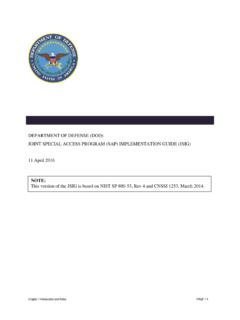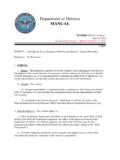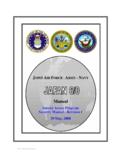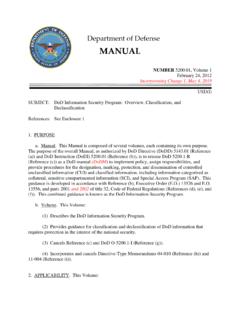Transcription of DoD 5200.1-R, January 1997 - GSA Container and Safe
1 1. DoD , January 1997 . 2 FOREWORD. DoD , January 1997 . 3 FOREWORD. DoD , January 1997 . TABLE OF CONTENTS. Page FOREWORD 2. TABLE OF CONTENTS 4. CHAPTER 1 - POLICY AND PROGRAM MANAGEMENT 7. POLICY 7. PROGRAM MANAGEMENT 9. special TYPES OF INFORMATION 10. EXCEPTIONAL SITUATIONS 11. CORRECTIVE ACTIONS AND SANCTIONS 12. PEPORTS 13. SELF-INSPECTION 13. CHAPTER 2 - ORIGINAL CLASSIFICATION 15. GENERAL PROVISIONS 15. ORIGINAL CLASSIFICATION AUTHORITY 15. THE ORIGINAL CLASSIFICATION PROCESS 16. special CONSIDERATIONS 19. SECURITY CLASSIFICATION AND/OR DECLASSIFICATION GUIDES 20. INFORMATION FROM PRIVATE SOURCES 23. CHAPTER 3 - DERIVATIVE CLASSIFICATION 26. POLICY AND GENERAL REQUIREMENTS 26. PROCEDURES 27. CHAPTER 4 - DECLASSIFICATION AND REGRADING 29.
2 GENERAL 29. DECLASSIFICATION DECISIONS BY ORIGINAL CLASSIFIERS 30. AUTOMATIC DECLASSIFICTION AT 25 YEARS 32. MANDATORY REVIEW FOR DECLASSIFICATION 35. SYSTEMATIC REVIEW FOR DECLASSIFICATION 36. DOWNGRADING 37. UPGRADING 38. FOREIGN GOVERNMENT INFORMATION 38. CHALLENGES TO CLASSIFICATION 39. 4 TABLE OF CONTENTS. DoD , January 1997 . TABLE OF CONTENTS, continued Page CHAPTER 5 - MARKING 41. GENERAL PROVISIONS 41. SPECIFIC MARKINGS ON DOCUMENTS 42. MARKING special TYPES OF DOCUMENTS 54. MARKING special TYPES OF MATERIALS 57. CHANGES IN MARKINGS 60. REMARKING AND USING OLD CLASSIFIED MATERIAL 62. FOREIGN GOVERNMENT INFORMATION/EQUIVALENT CLASSIFICATION 62. DESIGNATION. CHAPTER 6 - SAFEGUARDING 66. CONTROL MEASURES 66.
3 ACCESS 67. SAFEGUARDING 70. STORAGE 75. REPRODUCTION OF CLASSIFIED MATERIAL 81. FOREIGN GOVERNMENT INFORMATION 82. DISPOSITION AND DISTRUCTION OF CLASSIFIED MATERIAL 83. ALTERNATIVE OR COMPENSATORY CONTROL MEASURES 84. CHAPTER 7 - TRANSMISSION AND TRANSPORTATION 87. METHODS OF TRANSMISSION OR TRANSPORTATION 87. PREPARATION OF MATERIAL FOR TRANSMISSION 92. ESCORT OR HAND-CARRYING OF CLASSIFIED MATERIAL 93. CHAPTER 8 - special ACCESS programs 98. Policy 98. SAP Procedures 98. Control and Administration 100. Establishment of DoD SAPs 101. Reviews of SAPs 106. Annual Reports and Revalidation 107. Interim Reports 108. Changes in Classification 108. Termination and Transitioning of SAPs 109. 5 TABLE OF CONTENTS.
4 DoD , January 1997 . TABLE OF CONTENTS, continued Page CHAPTER 9 - SECURITY EDUCATION AND TRAINING 110. POLICY 110. INITIAL ORIENTATION 110. special REQUIREMENTS 112. CONTINUING SECURITY EDUCATION/REFRESHER TRAINING 115. TERMINATION BRIEFINGS 115. PROGRAM OVERSIGHT 116. CHAPTER 10 - ACTUAL OR POTENTIAL COMPROMISE OF CLASSIFIED INFORMATION 117. Policy 117. Reporting 117. Inquiry/Investigation 118. Results of the Inquiry/Investigation 120. Verification, Reevaluation, and Damage Assessment 120. Debriefings in Cases of Unauthorized Access 121. Management and Oversight 122. Additional Investigation 123. Unauthorized Absences 123. APPENDIX 1 - REFERENCES 124. APPENDIX 2 - DEFINITIONS 129. APPENDIX 3 - CONTROLLED UNCLASSIFIED INFORMATION 138.
5 APPENDIX 4 - special PROCEDURES FOR USE IN SYSTEMATIC AND MANDATORY 150. REVIEW OF CRYPTOLOGIC INFORMATION. APPENDIX 5 - CONTROL OF DISSEMINATION OF INTELLIGENCE INFORMATION 153. (to be provided at a later date). APPENDIX 6 - EQUIVALENT FOREIGN SECURITY CLASSIFICATIONS 154. APPENDIX 7 - PHYSICAL SECURITY STANDARDS 158. APPENDIX 8 - TRANSMISSION TO FOREIGN GOVERNMENTS 168. APPENDIX 9 - special ACCESS PROGRAM DOCUMENTATION 174. 6 TABLE OF CONTENTS. DoD , January 1997 . C1. CHAPTER 1. POLICY AND PROGRAM MANAGEMENT. POLICY. Purpose and Scope This Regulation implements Executive Order 12958 (reference (e)), "Classified National Security Information," and associated OMB directives within the Department of Defense.
6 It applies to all Components of the Department of Defense. It establishes the Department of Defense Information Security Program to promote proper and effective classification, protection and downgrading of official information requiring protection in the interest of the national security. It also promotes the declassification of information no longer requiring such protection. There is information, other than classified information, that has been determined to require some type of protection or control. This information is generally known as "controlled unclassified information." Guidance concerning the protection or controls required for such information may be found in a number of DoD. Directives, Regulations and Instructions.
7 However, since classified information and controlled unclassified information often exist side-by-side in the work environment, often in the same document, the essence of available guidance pertaining to controlled unclassified information has been captured in Appendix 3 of this Regulation. The purpose of the Appendix is to provide the user, to the extent possible, a single source document for guidance concerning both classified and controlled unclassified information. Policies All personnel of the Department of Defense are personally and individually responsible for providing proper protection to classified information under their custody and control. All officials within the Department of Defense who hold command, management, or supervisory positions have specific, nondelegable responsibility for the quality of implementation and management of the Information Security Program within their areas of responsibility.
8 Management of classified information shall be included as a critical element or item to be evaluated in the rating of original classification authorities, security managers or specialists, and other personnel whose duties primarily involve the creation or handling of classified information. 7 CHAPTER 1. DoD , January 1997 . Except for information subject to the Atomic Energy Act of 1954. (as amended) (reference (o)), Executive Order 12958 (reference (e)) and this Regulation provide the only basis for application of security classification to information within the Department of Defense. Information shall be classified only when necessary in the interest of national security, and shall be declassified as soon as is consistent with the requirements of national security.
9 Information shall not be reclassified after it has been declassified and officially released to the public by proper authority. Persons shall be allowed access to classified information only if they: Possess a valid and appropriate security clearance;. Have executed an appropriate non-disclosure agreement; and Have a valid need for access to the information to perform a lawful and authorized governmental function. DoD (reference (ss)) contains detailed guidance on personnel security investigation, adjudication and clearance. Classified information shall be protected at all times. See Chapters 6 and 7 of this Regulation. Classified information shall be maintained only when it is required for effective and efficient operation of the organization or its retention is required by law or regulation.
10 Classified documents and material that constitute permanently valuable records of the Government shall be maintained and disposed of in accordance with DoD Directive (reference (v)). Other classified material shall be destroyed in accordance with Chapter 6 of this Regulation. special Access programs shall be created, continued, managed, and discontinued in conformance with Chapter 8 of this Regulation. 8 CHAPTER 1. DoD , January 1997 . PROGRAM MANAGEMENT. Department of Defense. The Secretary of Defense has designated the Assistant Secretary of Defense for Command, Control, Communications, and Intelligence (ASD(C3I)) as the senior agency official responsible for direction and administration of the Information Security Program for the Department of Defense.








